C&S RPO 11: Linn Moedinger’s Shapeways Print in Sn3 and Hon3
123456
123456
|
This post was updated on .
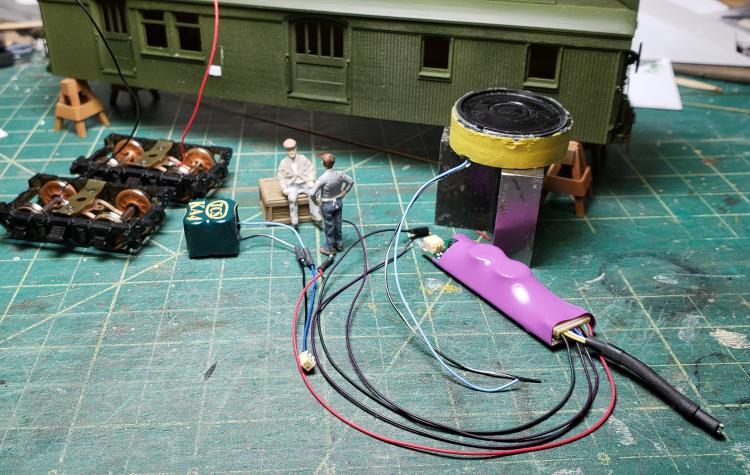 I worked on the electronic package today. The Soundcar, a Keep Alive and a speaker. Darrell turned me on to the TCS KA1s, which are evidently out of production, so I got a KA4 instead (The KA1 and KA4 still pack a punch but are smaller and don't have the capicator capacity of the Soundtraxx unit). Soundtraxx requires a special connection for a keep alive. They were kind enough to send me some. I looked into hard wiring this, but the connection is tiny. The Soundcar came with a 1" speaker. I painted the enclosure to match the interior. I painted the trucks black. PBL makes a nice accommodation to power the trucks. The Soundcar will be on the roof, and it is likely that the trucks will need to be separated so connectors are provided. (I wish Soundtraxx would drill the back of the female connector to make it easier to solder).
Keith Hayes
Leadville in Sn3 |
|
Administrator
|
In reply to this post by Jim Courtney
Jim and Keith and all, thanks for all the updates on these Baggage/Postal cars. I've been real busy with work recently an am catching up on some of this stuff.
Jim, one of the things you wrote that struck a chord with me was the comment about no postal service West of Como after 1929. I was unaware of that. Some time ago, we discussed the odd practice of running the Postal cars backwards as was clearly done. The number of photos in recent years which show the postal end forward, as it should be according to the Mail Contract, and the baggage end first seem to be half and half. As I recall, we concluded that the train was not turned in Leadville in later years, but was just switched so the coach was in the rear, with the seats flipped forward. If there was no mail service West of Como, but the car itself continued in the train, there would have been no contractual reason to run the postal end forward, and could simply have been random from however the train was switched in Como. Or, perhaps none of this means anything at all. But it is an interesting aside. Other contractual requirements of Postal Cars were removal of end platforms, the cast steel trucks with inboard brakes, the blind end on the postal end of the car, and steel reinforcing in both the postal end wall, with fire retardant treatment, and the underframe. This accounts for much of the similarity in appearance of the C&S and orher postal cars, such as on the D&RGW. |
|
This post was updated on .
Mike,
I believe you misunderstood my comment about the RPO service on the Leadville passenger train in the 1929 photo, re: going only as far as Como. Perhaps we should review the history of passenger operations and RPO service over the High Line, including your Dickey: Per Mac Poor and Cornelius Hauck, the new C&S established through Denver-Leadville mail service with RPOs in 1901. First decade photos of South Park Division passenger trains show both RPO-baggage and RPO-Coaches in the consists. 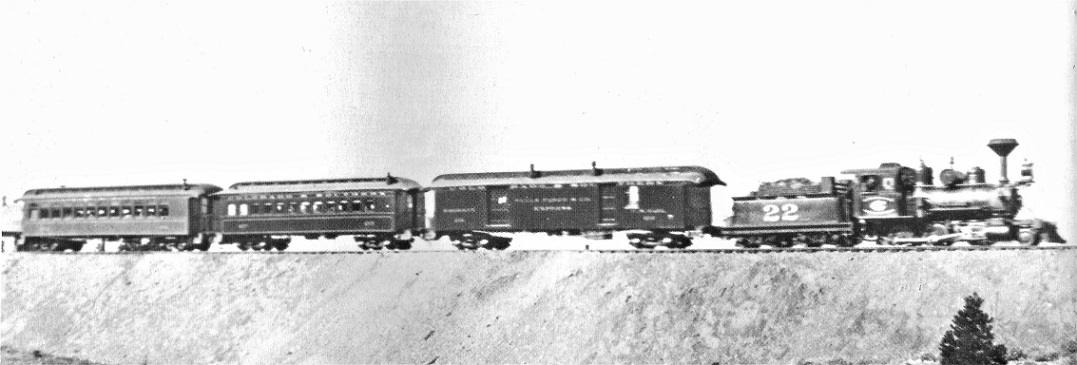 Ronfor Collection, in Grandt's Narrow Gauge Pictorial VI. Leadville c1903. The RPO behind C&S 22 will later be rebuilt into our familiar RPO 13. 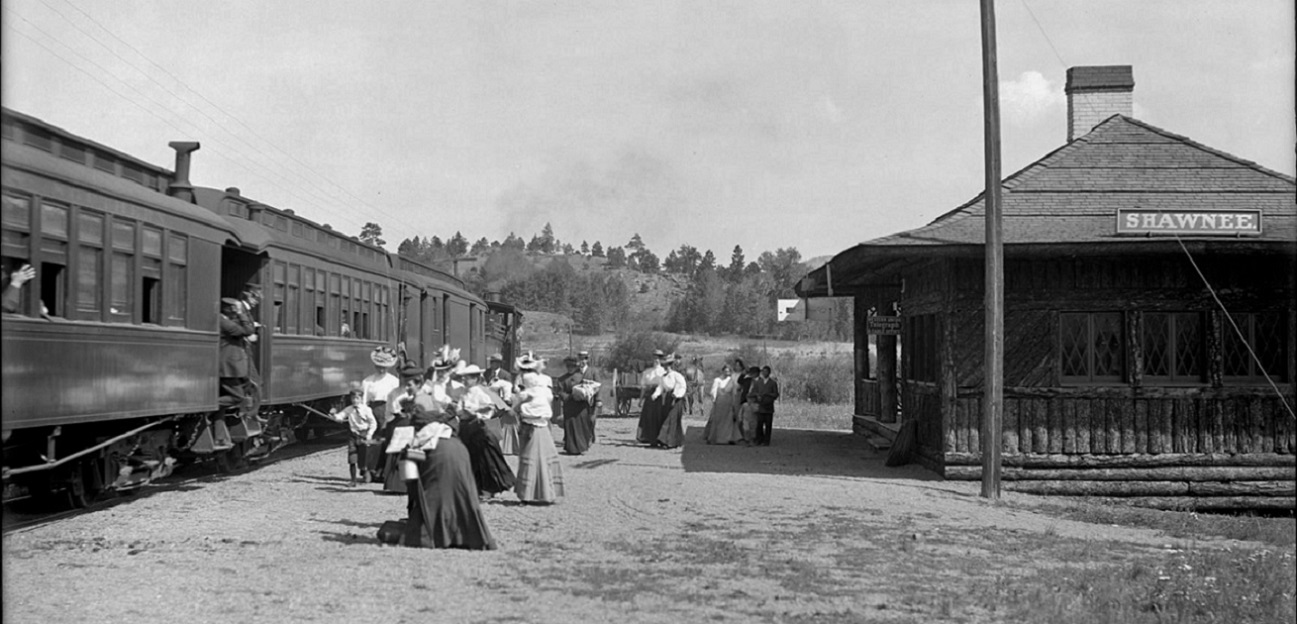 McClure photo, DPL. Shawnee, c1905. Two door baggage car (later C&S 1 or 2) and RPO-Coach at head end. Remember that in 1911, the run over Boreas was closed by the new CB&Q management. Passenger trains 71-72 ran only Denver to Como, including mail service. Breckenridge and Dillon were served by a passenger turn out of Leadville, out and back daily. Not sure if mail was handled, the only photo of such train shows a combine and coach, though the combine looks to be one of the RPO-Coaches 40-43. Maybe Ken Martin can opine here.  Otto Westerman photo in Kinding, et al, The Pictorial Supplement . . . Public and legal pressure from the state resulted in the C&S resuming through Denver--Leadville passenger service in 1913, including RPO service. According to Rail Annual 12, RPO service from Como to Leadville was again discontinued west of Como in 1917. Passenger service continued to be Denver-Leadville, daily except Sunday. When the passenger trains 71-72 became tri-weekly runs in 1931, through Leadville RPO mail service was re-instituted and continued until abandonment of the South Park mainline in 1938. So, from 1917 to 1931, the RPO out of Denver was operated as the "Denver & Como" RPO and mail handled locally along the line was so post marked. A lot of photos of the Denver-Leadville train from the late teens to late 1920's show the Mail-Coaches 40-43 in the consist, with a baggage car ahead and one or more coaches behind. I've often wondered if the coach portion of cars 40-43 was a designated smoking section.  R.J. Jackson photo, Crossens tank, 1929. As we've discussed in another thread, the Mail-Coaches ran only so far as Como, where they were cut out of the west bound train on arrival (the arriving train had turned on the wye east of town and backed to the depot, so the RPO section was pointed east), then cut into the east bound passenger train for the return to Denver. Denver-Como mail clerks made a daily round trip. From Como to Leadville a baggage car handled the express business and a single coach usually sufficed for the dwindling passenger traffic. 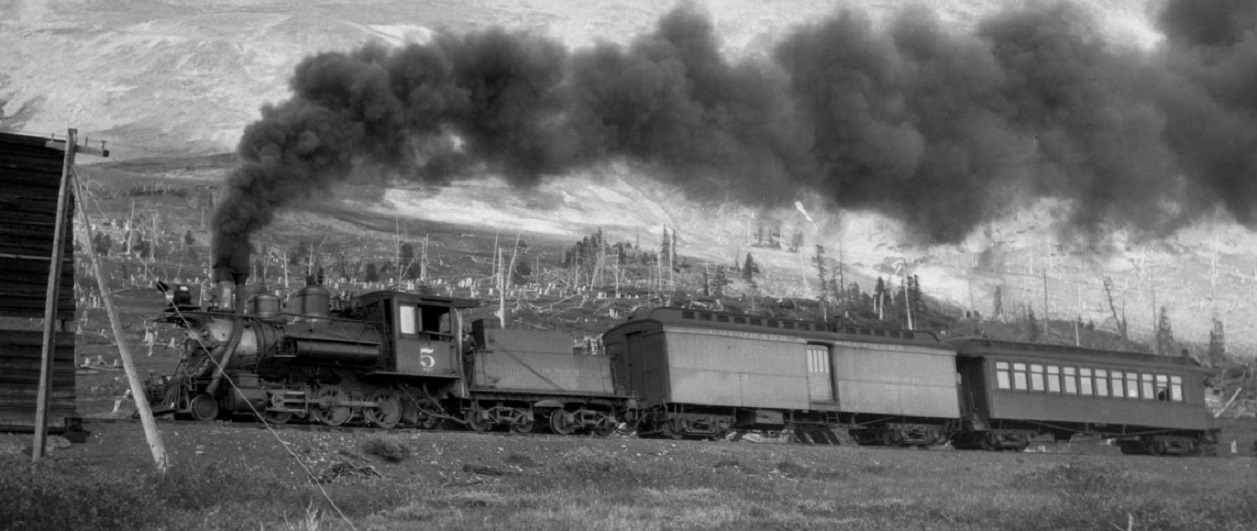 Otto Perry photo, near Boreas Snowshed, also 1929 When express business was light (winter perhaps), one of the RPO's 10-13 might be used in lieu of the RPO-Coach, if the through express business could be handled in the baggage compartment of the RPO. An example would be RPO 11 in the passenger train at Buffalo, in my post above in this thread. If an RPO was used in the consist, the mail clerk likely de-trained at Como and the RPO section was run locked and empty from Como to Leadville and return. After through Denver -- Leadville mail service returned on the tri-weekly trains after 1931, express business had fallen off, there were fewer passengers and the mail contract was the money maker that kept the passenger trains running. The usual two car consist of RPO and coach became the norm, usually RPO 13, occasionally 10, 11 or 12: 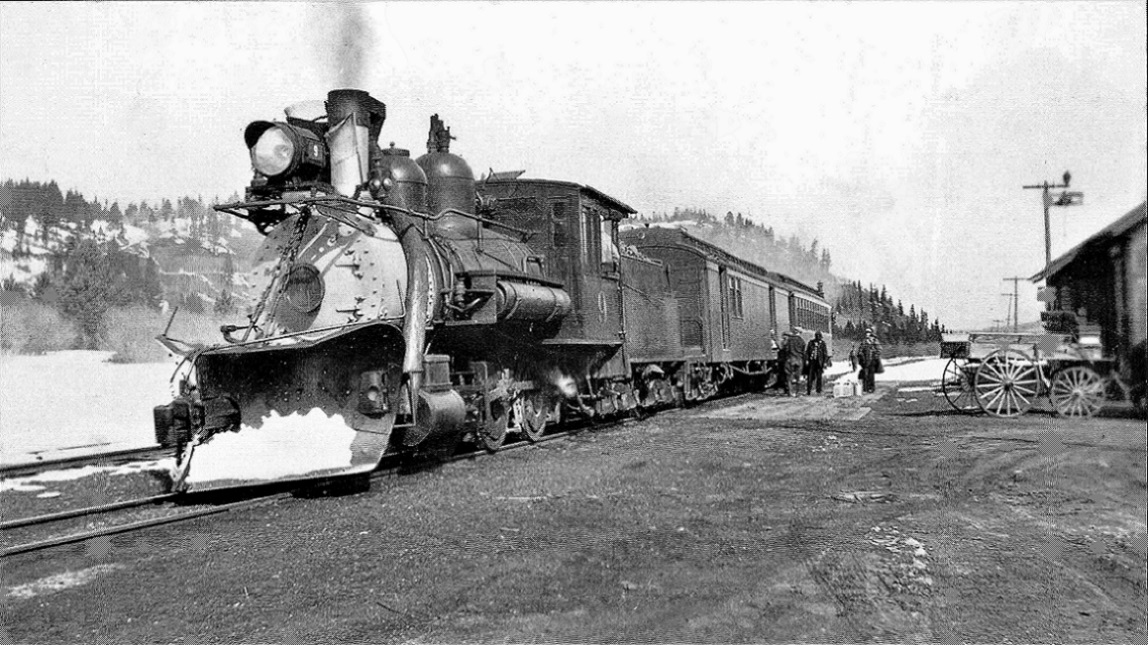 If express business was unusually heavy on a given day in the mid to late 1930s, a baggage car 1-4 might be added to the head end:  Both photos Breckenridge, 1935. Note RPO 10-11-12 in lower consist. This scenario likely explains no photos of the mail coaches 40-43 after 1930. Hope this explanation helps . . .
Jim Courtney
Poulsbo, WA |
|
Thank you for the illustrated response, Jim.
I personally like the short, double door express cars. I am not seeing them in these trains. I still am wishing for a 3d print of one, as I prefer the contrast of the shorter passenger car to the longer, single door versions. This does make the case for the RPO-coach 40-43. In fact the express / RPO coach / coach train (maybe with a second coach?) would make for quite a long train for 71-72. Perhaps someone among us more curios than myself can educate us on RPO rules? My Spidey sense tells me that the clerk would not lock up the RPO in Como and let the car go on to Leadville alone. Seems to me there would be mail, possibly returning to Denver, and they would be obliged to stay with the mail until it got to Denver or Leadville. Though there would not be much, I cannot imagine them unloading a bag and overnighting it in the Como PO. Where did the mail clerk spend the night in Como, or Leadville? I trust they rode the train the entire distance, unlike the engine crews?
Keith Hayes
Leadville in Sn3 |
|
Keith,
I personally like the short, double door express cars. I am not seeing them in these trains. Look again at the first decade train stopped at Shawnee. The first head end car is one of the short express cars, before the 1906-1910 rebuilding, when the end platforms and small side windows were removed. Perhaps Chris or Ken can comment, but I suspect that the short express cars 1 and 2 were more often assigned to Clear Creek runs with the shorter round trips, while the two larger express cars 3 and 4 were used on the much longer Denver-Leadville run. I'd like both a short 2 door car and a long single door car as a print. But that doesn't mean that the short cars never made the trip to Leadville -- here you go, the eastbound passenger making the station stop at Dillon in the mid 1920's:  Photographer unknown, Courtney collection. Unusually heavy motive power for the passenger train! After Mike sees the train pass back through Dickey for the second time, and the two car train arrives at Como, the RPO-Coach with mail clerk from the eastbound train will be cut into the train between the express car and coach and return to Denver. In fact the express / RPO coach / coach train (maybe with a second coach?) would make for quite a long train for 71-72. Maybe in the 1930s, but such trains were common out of Denver in the early 1920's. Consider these two Otto Perry portraits: http://digital.denverlibrary.org/cdm/fullbrowser/collection/p15330coll22/id/42509/rv/singleitem/rec/21  C&S 21 leaves Denver for Como in 1918 with a 5 car consist. http://digital.denverlibrary.org/cdm/fullbrowser/collection/p15330coll22/id/42471/rv/singleitem/rec/6  C&S 9 leaves Denver at the same location in 1922 with a 4 car consist. The head end cars are the same on both trains, express car 3 and RPO-Coach 41-42-43. My Spidey sense tells me that the clerk would not lock up the RPO in Como and let the car go on to Leadville alone. This is speculation on my part -- from 1931 'til 1938, the RPO clerk would stay with the RPO all the way Denver to Leadville. All mail and express would be unloaded at Leadville and the clerk would lay over. The next morning, the clerk would load all eastbound mail for Denver. In the years 1917 to 1931, the mail clerk would stay with the RPO-Coach, Denver to Como. The RPO-Coach would be turned and cut into the eastbound train for the return trip to Denver. In seasons when there were fewer passengers and less express, one of the RPOs 10-13 would serve the purposes of two cars (the express car and RPO coach) as long as the express for those trips could be accommodated in the baggage part of the RPO and all the passengers would fit into one coach. In such instances both the eastbound train from Leadville and the westbound from Denver would carry an RPO. The mail clerk still made a daily round trip Denver-->Como-->Denver. At Como mail for that station would be unloaded, any remaining collected mail in the Denver RPO would be transferred to the Leadville RPO, along with accumulated mail from Como, Faiplay and Alma for the trip to points east. The mail compartment on both RPOs would be locked and empty between Como and Leadville. So, someone needs to explain to me how mail got to Climax, Breckenridge and Dillon between 1917 and 1931. It obviously arrived in Leadville on the broad gauge D&RG. Was there a locked compartment in the express cars that bags of "storage mail" could be carried to points between Leadville and Dickey?? Finally, I would really like a print of Combine number 30. Remember, between 1917 and 1938, there were no regular passenger trains running on the South Park on Sundays. But in the summers, the Fish Train (train number 70) ran Sundays only, west bound from Denver in the morning to Grant, and had a very early Monday morning departure (train 73) from Grant to allow fishermen to get back to work in Denver Monday morning. Number 30 was almost always in that consist: http://digital.denverlibrary.org/cdm/fullbrowser/collection/p15330coll22/id/42516/rv/singleitem/rec/17  C&S 18 departs Denver one Sunday in 1920 with a two car Fish Train. http://digital.denverlibrary.org/cdm/fullbrowser/collection/p15330coll22/id/42455/rv/singleitem/rec/7  C&S 8 at Sheridan Jct one Sunday in 1931 with a three car Fish Train. In other news, I finally have 6 days in a row off -- maybe I'll make some progress on the HOn3 version of RPO 11. 
Jim Courtney
Poulsbo, WA |
|
Administrator
|
This post was updated on .
In reply to this post by Keith Hayes
Thanks for the detailed and expansive information.
I would still contend that if mail service west of Como was not continued in later years, the Baggage and Mail Car was still, inarguably, present in every train. It was the presence of the clerk and mail that made the car a Railway Post Office. The USPS may only have routed mail between Denver and Como in later days, and used the train for delivery between those points as a less expensive alternative than trucking. The clerk would simply have laid over in Como for the return to Denver the following day. The Postal end would be locked, and pretty cold the following morning in Winter. If this was the case, the USPS would have routed mail to Leadville and the region on Standard Guage RPO's and then trucked it from there between Frisco and Breckenridge. Mail between Frisco and Dillon could have been done in a car or small truck, same as it would have been to other small places not on the railroad. Climax, Kokomo and other places could easily have had mail delivered by a truck which ran each way between Leadville and Breckenridge every day, just as they did after April 1937. This actually makes sense to me, and the Baggage and Mail car was used only for baggage between Como and Leadville in later years. Remember this was also the middle of the great depression. Easy to imagine this as a result of that. It probably also eliminated a Railway Postal Clerk's job. So this actually could have happened, but who knows how that could be proven. All I can say for sure is that I see a mail clerk in the postal end of car #13 as it rolls through Dickey 6 times a week in three times weekly service. |
|
In reply to this post by Keith Hayes
Keith, I suspect that a brass Sn3 passenger car would be over $500 today and I suspect that a run of 150-200 would be minimum. These could be different variations or perhaps even styles of cars. It has been a number of years since the PBL cars were done. Time slips by...I have three of the PBL RGS cars...which came close to the cost of a PBL locomotive...
Best, Todd |
|
In reply to this post by Jim Courtney
Jim,
I believe that Soho also made a C&S coach in HOn3 in the 1970s. At least that is what I recalled the one I owned and painted RGS being labeled. But of course my memory could be failing me too... I have designed multilayer laser cut sides and ends for passenger cars in Sn3 and I think that could still hold some promise for HO, S and even O scale models. The sticking point is the always the roofs. I have tried some different laser cut ideas in Sn3 but the problem becomes that some of the parts become small and fragile. Mark Evans built some very nice RGS work cars that were former passenger cars used on Tomalco kit bits and pieces and styrene. He scratched the roofs out of styrene and they came out pretty nice. In HO and S the roofs could probably be 3D printed at a reasonable cost. In O we have the Bachmann car roofs and the San Juan roofs as possibilities. The design work to do laser cut parts is probably less or no more than the 3D modeling to do printed car parts. Most people can work in 2D CAD easier than in 3D CAD and it is very inexpensive to get 2D software. My layered approach allowed the windows to be built up and also for the inside cuttings to have laser etched board details to as I think passenger cars with interiors are nicer than those without. Brass cars can be hard to finish interior wise both in paint and details as I am sure you and others are aware. I do believe that the cost and quality of 3D printing will continue to improve and the cost will continue to fall just as it as with laser cutting. 3D Systems which invented 3D printing in the late 1980s is located about 45 minutes from me in Fort Mill, SC. I was involved in come early 3D printing development and implementation at GM in the late 1980s. If we can go another 15-20 years we will likely have inexpensive high resolution 3D printers on our workbenches at a reasonable cost. Best, Todd |
|
In reply to this post by Keith Hayes
Slow progress. We added the mail slots and the extra lamp vents. Also the water filler hatch in the RPO section is finished.
 Trucks and couplers are mounted and I am still waiting on needle beams/ queen posts so I can install truss rods and brakes. It makes a sweet train. And the mail section is even forward!
Keith Hayes
Leadville in Sn3 |
|
Keith,
you seam to have a coupler height challenge with the locomotive in front of your RPO? |
|
Al, I posed the car with #9, which currently has a hitch-in-its-get-along that I have yet to need to diagnose. The coupler on 9 may be a bit low. Also, the car is at a point where the track starts downhill to the right. That said, I do need to balance the desire to have the car at the correct height per the folio and get the couplers to align per the standard. This may require an underset coupler.
This is, in part, why I elected to install the couplers with a screw rather than gluing the box together and then gluing the box to the body. I cannot speak for you all, but in the 5 years I have had the layout, I bet I have had about six couplers fail for various reasons. I think I take reasonable care of the models, but either a portion of the coupler fails, or my resistance to apply a lot of cement to the box fails. Either way a bad order car results. Screws will make the repair more speedy, I hope. In other news, I ordered some brass wire and chain from Clover House and it arrived today. My local hobby shop does not seem to find scratch building supplies to be a profit center. I was very pleased with the prompt service from Clover House and their 10-links-per-inch chain will be PURRFECT for safety chain in Sn3! 
Keith Hayes
Leadville in Sn3 |
|
Safety chains
 Coupler pin lift bars  Installed 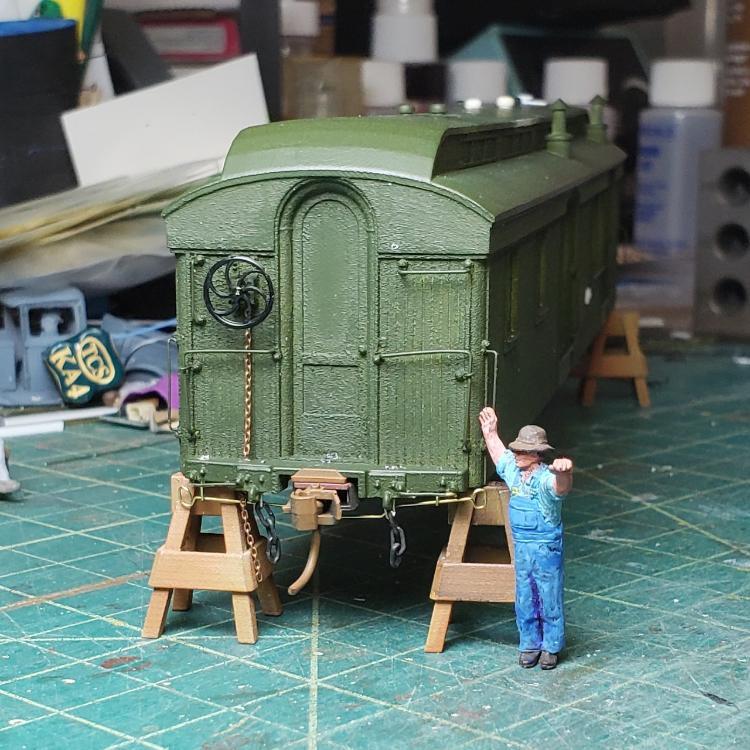
Keith Hayes
Leadville in Sn3 |
|
As the carbody is nearing completion, one detail remains that I have actually not given much thought to: the security (safety?) bars inside the RPO windows.
Anyone know of a etching of this part appropriate for this scale of car? Otherwise, I guess I get out the brass wire and trusty soldering iron and create me some bars. Also, were the bars painted black or silver (or USPO green / ochre)? Are they silver on my RPO 13 because Overland got some etchings from another (stainless steel) project? Could I emulate these with decals on the inside of the glass?
Keith Hayes
Leadville in Sn3 |
|
This post was updated on .
Hang on, Keith!
I've finished my HOn3 RPO 11 floor last night and I am working on the coupler mountings, finally noticed one important thing: Linn printed a coupler draft gear "notch" in the original HOn3 car design -- remember, your Sn3 print is simply a blown up HOn3 car, so the "notch" is proportionately wider and deeper. C&S passenger cars sat high on their trucks, usually 36" from the bottom of the floor under sheathing to the top of the rail. Couplers were mounted so the center line of the shank was 26" above the top of the rail. The couplers on C&S passenger cars went under the end beams, not through them. This probably explains your coupler height mismatch, with your locomotive number 9. I am planning to cover the "notch" in the endbem with a piece of thin (0.010 x 0.100) Evergreen styrene and then mount Sergent scale operating knuckle couplers under the car using an Accurail HO "scale" draft gear box. Photos to follow soon (I hope). As to the safety rails inside the RPO windows, I can consult my "Quik-Pic" book for RPO 13 as to color tomorrow; working in the hospital today. 
Jim Courtney
Poulsbo, WA |
|
Interesting point, Jim. Now I need to consult my drawings of D&RGW 053 to see where the coupler is there. About all I recall from rebuilding the end platforms on that car was that we took a lot of big pieces of wood and created a lot of sawdust between all the mortises and holes we put on the parts and pieces. On passenger cars, the structural box ends at the end wall, and the platform is effectively held on with some steel rods and a stout prayer.
Keith Hayes
Leadville in Sn3 |
|
Compare the end of your RPO 11 with the photo at Waterton:
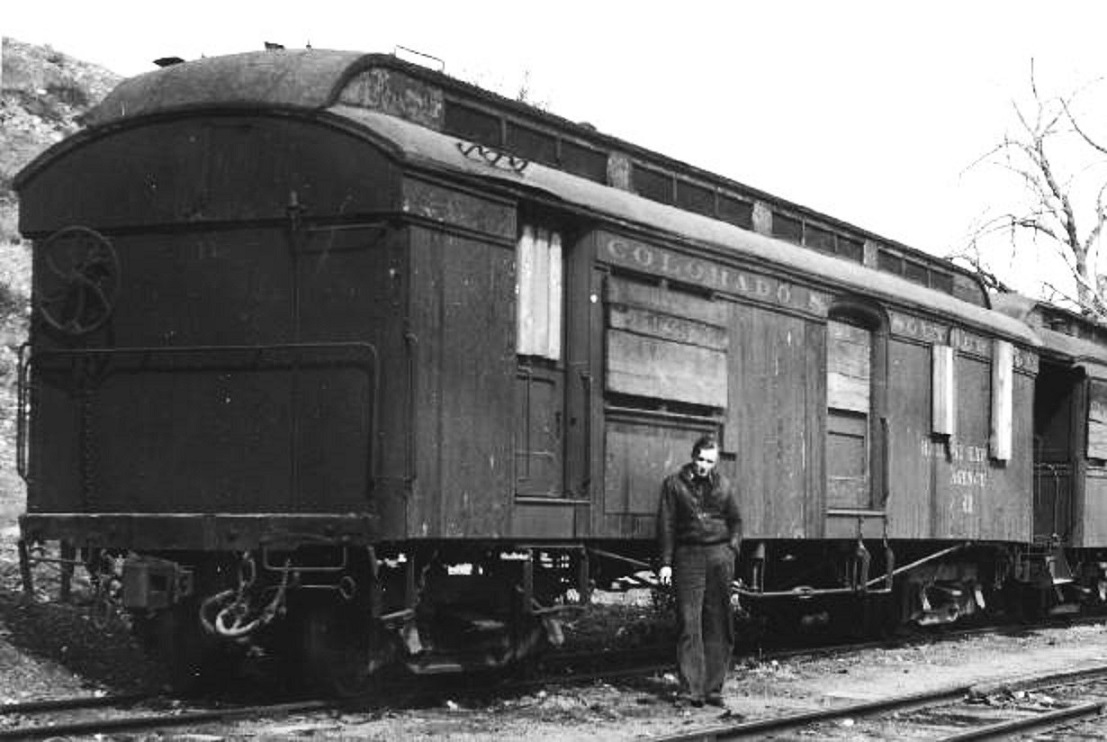 I was going to cover the "notch" with thin styrene, but it looks to have an additional coupler block (like on an early freight car) of wood, sheathed in sheet metal, on the end beam above the coupler.
Jim Courtney
Poulsbo, WA |
|
Thanks, Jim. I need to place the car on flat track and carefully assess the coupler height. One end seems just fine, and the other a bit high.
Keith Hayes
Leadville in Sn3 |
|
In reply to this post by Keith Hayes
Hey Keith, Do you remember Dave Sands putting some blood, sweat & tears into the 053 platforms?!
He got bit by the band saw cutting those puzzle pieces. Those drawings you did of the 053 were great! I was very disappointed that it was resided and the mismatched siding was not continued. The car had the three different sizes in photos during the 30s, probably since the doors were covered up entering MOW service in 1929. I did see the chunk of telephone pole I patched into the quarter round is still there though. Tony |
|
In reply to this post by Keith Hayes
Jim, I found the flattest piece of ground in Leadville.
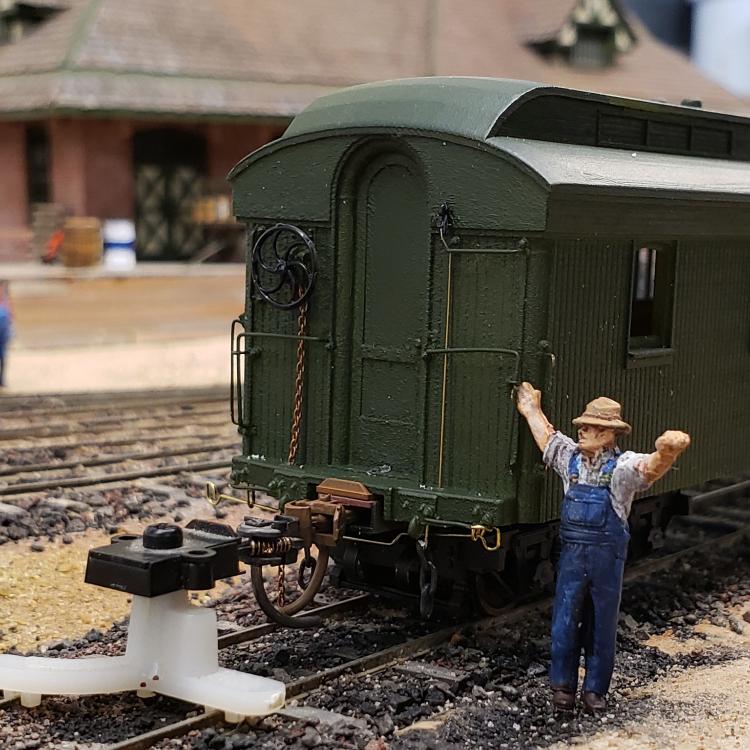  You judge for yourself, but the couplers appear to match the PBL gauge closely. You will also be relieved to know I added the retainer to the baggage end today. Now I am just waiting for needle beam/ queenposts. Tony, I do recall those parts gave Dave fits: you really need big tools to work on railroad equipment!
Keith Hayes
Leadville in Sn3 |
|
This post was updated on .
Have you checked the body height above the rail, to make sure the car body is sitting high enough (36") above the rail?
In HOn3, a piece of dual gauge flex track works great, the inside jaws of a dial caliper will fit between the two rails on the third rail side and the bottom of the car. In HO scale, 3 feet is a smidgen less than 0.040 inches, in S scale it's about 0.54 inches. The only "low riders" on the C&S were the coal cars.  (not trying to be nit-picking, just trying to reconcile the coupler "notch" in the print to the prototype)
Jim Courtney
Poulsbo, WA |
«
Return to C&Sng Discussion Forum
|
1 view|%1 views
| Free forum by Nabble | Edit this page |

